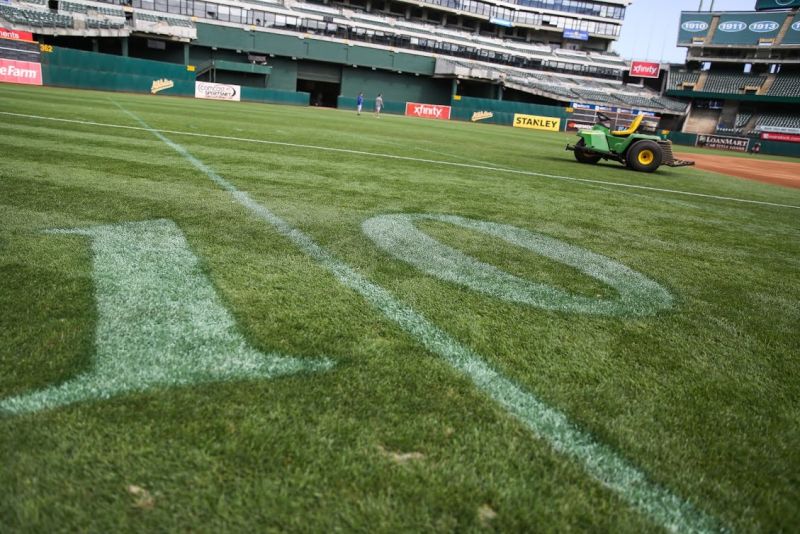But that all changes after the A’s start taking turns with the Raiders. To go from football back to baseball is a massive operation. Dozens of workers, including stagehands, crane operators and janitors, must all work in tandem to remove extra seating from the outfield and infield grass, change signage, swap the tarps that cover the top deck seating, and exchange goal posts for foul poles.
Clay and his modest crew of eight have their hands full making the conversion. After a football game, or sometimes two in a row (as was the case before the last A’s homestand), the grass of the facility can get pretty roughed up.
While the football game itself takes a toll on the turf — it is, after all, a sport centered around men slamming other men into the grass with great force — Wood says it’s the changeover itself that really hurts. In order to facilitate the movement of huge, heavy cranes that place and remove extra football seating, layers of plywood and felt are laid over the outfield grass, creating a makeshift roadway. Wood likens the treatment to suffocation.
“It’s like if somebody were to take you and duct tape your mouth, and lock you in a closet, and while they’re at it, duct tape your nose, too, so you can’t breathe. Basically, the turf — it’s a living, breathing thing; it needs sun, it needs water, it needs all those things to live, and when it’s covered with plywood and hundreds of tons of cranes, it’s not getting any of those things.”
The Athletics’ vice president of stadium operations, David Rinetti, marvels at the ease with which Wood and his small crew handle the changeover, saying it’s like watching magic. They’ve done it so many times, they know the routine backward.
“But they’re also perfectionists,” Rinetti says. “They want the field to be perfect. They treat it as if it’s their baby, and they do everything possible to protect it, and to make it so it will be playable for our games here, for baseball.”
For the baseball players, especially the outfielders, the difference between April and September turf is big. After coming home from a recent road trip, A’s outfielder Sam Fuld said returning to the post-changeover grass reminded him a bit of his high school baseball field in New Hampshire, which was like a cow pasture.
“It’s just more uneven, and on ground balls you just have to really focus in, and not take anything for granted, and realize that there’s a good chance you’re going to get a bad hop,” Fuld says. “You have to be conservative.”
As for Wood, seeing the field he and his crew have labored over change from a masterpiece of cross-hatched green grass and finely detailed dirt into a trainwreck of neon-yellow crusty turf and divots — it hurts.
“It’s kind of a punch in the gut,” Wood says. “How does it get from that point to this point? In April, May, June, all the way up until that first conversion, my crew and I, we put in a ton of time and we take a ton of pride in what we do, and try to make it the best possible playing surface that we possibly can. And then all that work and all that effort and everything is just kind of out the window.”
With the future of where both the A’s and the Raiders will play still up in the air — like a towering pop fly, or a Hail Mary that just won’t come down — there’s no way to know when the Coliseum in Oakland will be home to just one sport and one field. The Raiders’ current lease expires at the end of this football season.
So for now, the man tasked with running the only remaining professional football and baseball facility in America doesn’t know whether he’s done the last baseball-to-football changeover of his career. And he’s not wistful about the possibility.
“Right now, to be honest, I’m tired, really tired and looking forward to a break,” Wood says. “And, unfortunately, that’s going to mean baseball coming to an end, but that’s just the way it goes some years.”

